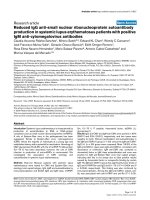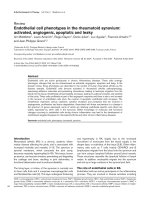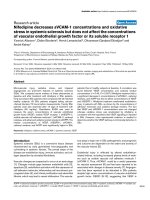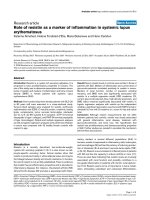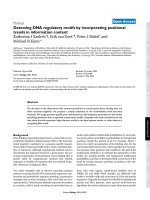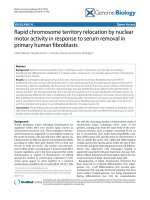Báo cáo y học: "Endothelial Cytomegalovirus infection monitored by quantitative real-time PCR in critically ill patients" pps
Bạn đang xem bản rút gọn của tài liệu. Xem và tải ngay bản đầy đủ của tài liệu tại đây (260.5 KB, 2 trang )
Cytomegalovirus (CMV) reactivation has been widely
documented in the past 10 years in critically ill patients
[1]. Conversely, few data are available on burn patients
despite experimental studies showing that these patients
are predisposed to herpes virus infections [2]. To our
knowledge, only two studies reported the incidence of
CMV infection in burn patients using a modern tech-
nique, such as PCR, which has become the gold standard
[3,4]. ese two studies demonstrated a high rate of CMV
reactivation, 55% and 71%, respectively. Moreover, CMV
reactivation in burn patients has been proven to be
intense. Indeed, in the study of Bordes and colleagues [4],
67% of patients who reactivated CMV experienced
viremia greater than 1,000 copies/ml, and 33% viremia
greater than 10,000 copies/ml. ese results may refl ect
the severe immunosuppression that characterizes ther-
mally injured patients. Consequently, severe burn
patients could be considered as a model for CMV
reactivation in critically ill patients. However, the precise
kinetics of CMV DNA load in these patients is still poorly
docu mented. at is why we would like to briefl y present
data from longitudinal monitoring of CMV infection by
real-time PCR (RT-PCR) in four severe burn patients
during their ICU stay (Figure 1).
All the patients were CMV IgG seropositive on admis-
sion. ey were monitored for CMV reactivation once to
twice a week. Detection of CMV DNA in blood samples
was performed by quantitative RT-PCR on whole blood.
e patients’ characteristics are described in Table 1.
Patient 2 presented a CMV-associated hemophagocytic
syndrome and was treated by ganciclovir for a duration
of 21 days. DNAemia became undetectable in patients 3
and 4 spontaneously. ese examples demonstrate that
critically ill patients may experience several episodes of
CMV reactivation during their ICU stay, and that CMV
viral load can be very changeable. Furthermore, CMV
viremia may be highly variable over a short period.
In our opinion, CMV reactivation in critically ill
patients should be monitored with quantitative methods
of detection, such as RT-PCR. Indeed, we hypothesize
that the potential role of CMV on patient outcome is
mostly due to the intensity of CMV reactivation rather
than the CMV reactivation per se. at is why we suggest
that studies aimed at determining the role of CMV
reactivation as a contributor to outcome in critically ill
patients should use quantitative methods of detection.
Consequently, a CMV viremia threshold could be deter-
mined to guide preemptive therapy in these patients.
Written consent for publication was obtained from the
patients or patients’ relatives.
Abbreviations
CMV, cytomegalovirus; PCR, polymerase chain reaction; RT-PCR, real-time PCR.
Competing interests
The authors declare that they have no competing interests.
Author details
1
Teaching Military Sainte Anne Hospital, Department of Intensive Care and
Anesthesiology, BP20545, 83041 Toulon Cedex 9, France.
2
Burn Center, Sainte
Anne Hospital, BP20545, 83041 Toulon Cedex 9, France.
3
Laboratory of Biology,
Sainte Anne Hospital, BP20545, 83041 Toulon Cedex 9, France.
Published: 18 March 2011
References
1. Osawa R, Singh N: Cytomegalovirus infection in critically ill patients:
asystematic review. Crit Care 2009, 13:R68.
2. Kobayashi M, Herndon DN, Pollard RB, Suzuki F: CD4+ contrasuppressor
Tcells improve the resistance of thermally injured mice infected with HSV.
JLeukoc Biol 1995, 58:159-167.
3. Limaye AP, Kirby KA, Rubenfeld GD, Leisenring WM, Bulger EM, Ne MJ,
Gibran NS, Huang ML, Santo Hayes TK, Corey L, Boeckh M: Cytomegalovirus
reactivation in critically ill immunocompetent patients. JAMA 2008,
300:413-422.
4. Bordes J, Maslin J, Prunet B, d’Aranda E, Lacroix G, Goutorbe P, Dantzer E,
Meaudre E: Cytomegalovirus infection in severe burn patients monitoring
by real-time polymerase chain reaction: A prospective study. Burns 2011
[Epub ahead of print].
© 2010 BioMed Central Ltd
Cytomegalovirus infection monitored by
quantitative real-time PCR in critically ill patients
Julien Bordes*
1,2
, Tiphaine Gaillard
3
, Jérôme Maslin
3
, Pierre Esnault
2
, Philippe Goutorbe
2
and Patrick Brisou
2
LETTER
*Correspondence:
1
Teaching Military Sainte Anne Hospital, Department of Intensive Care and
Anesthesiology, BP20545, 83041 Toulon Cedex 9, France
Full list of author information is available at the end of the article
doi:10.1186/cc10066
Cite this article as: Bordes J, et al.: Cytomegalovirus infection monitored by
quantitative real-time PCR in critically ill patients. Critical Care 2011, 15:412.
Bordes et al. Critical Care 2011, 15:412
/>© 2011 BioMed Central Ltd
Table 1. Patient characteristics
Patient Age (years) TBSA (%) DBSA (%) IGS 2 score ICU stay (days) Viremia peak
a
Outcome
1 80 15 0 41 30 9,130 Discharged from ICU
2 76 40 40 38 141 63,400 Died in ICU
3 82 15 15 54 133 130,000 Discharged from ICU
4 60 28 20 29 105 137,000 Died in ICU
a
Viremia peak is expressed in copies/ml. DBSA, deep burn surface area; TBSA, total burn surface area.
Figure 1. Cytomegalovirus plasma load measurements during ICU stay of four severe burn patients.
Bordes et al. Critical Care 2011, 15:412
/>Page 2 of 2


